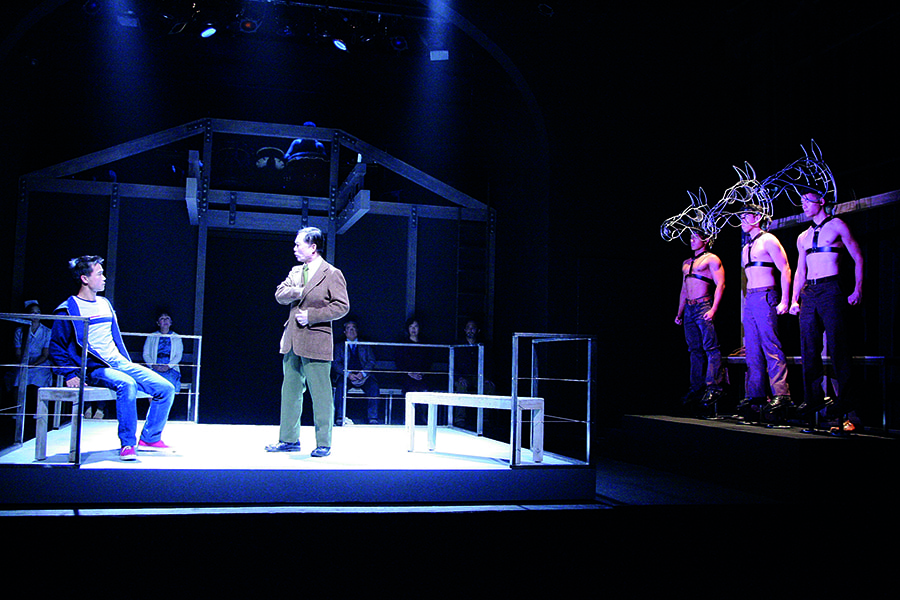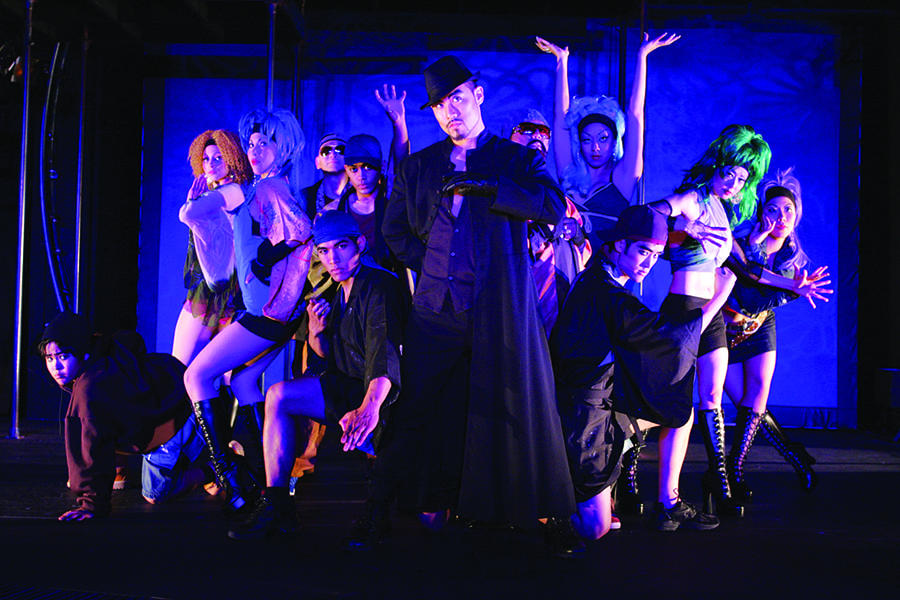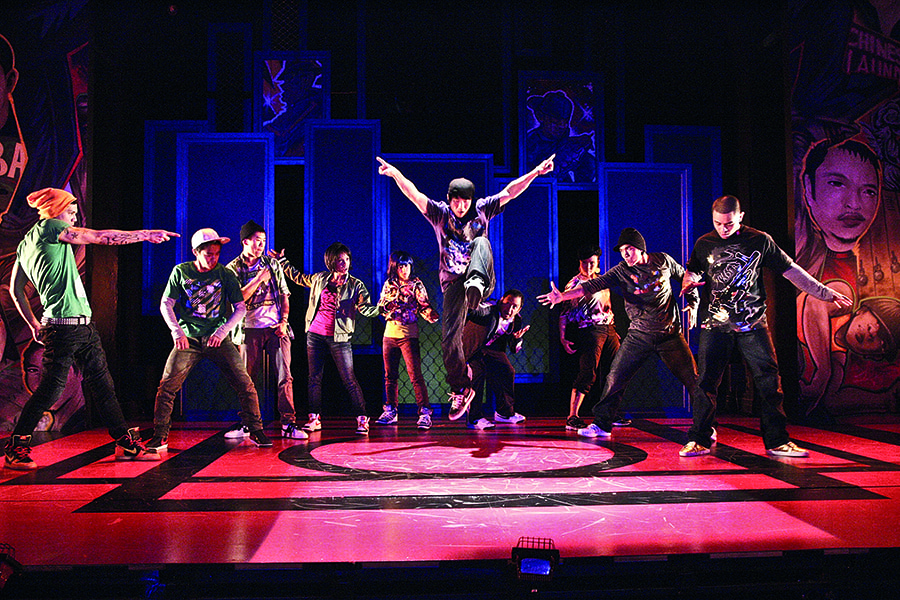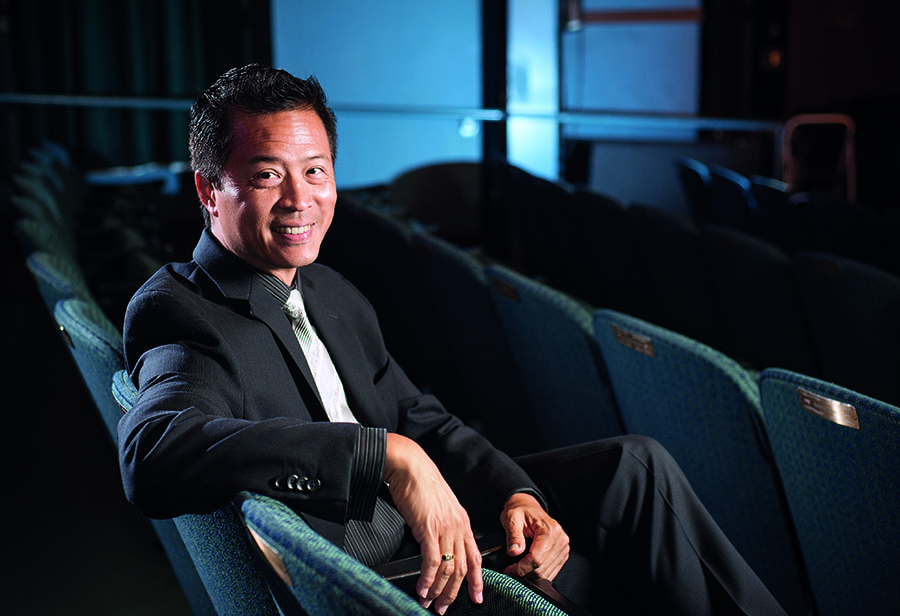In 1980, when Tim Dang was getting ready graduate from the University of Southern California, one of his college professors gave him some hard-hitting advice. “He informed me that of all the people in my senior class, I was going to have the toughest time making a living as an actor,” Dang recalled.
Now 55, Dang, a Hawaiian-born Chinese-American, had been used to playing lead roles with multicultural casts at USC. Back in Hawaii, he had been part of the dominant population. But, as his professor told him, the world on the mainland was less inclusive. “He said, ‘East West Players does really great work, I think you’ll find a home there.’”
Soon after graduation (with a degree in acting, emphasis on musical theatre), Dang joined the Los Angeles–based company, then an ensemble of around 100 artists. In 1993, Dang was made the producing artistic director; 2013 is his 20th year at the helm. Counting back to his first involvement in 1980, EWP has been Dang’s artistic home for more than 30 years. The professor was right.
Founded in 1965, EWP is now the largest Asian-American theatre in the nation, and its oldest continuously operating theatre of color. Under Dang’s leadership, the theatre transitioned from a 99-seat black box to a 240-seat proscenium. The budget grew from $350,000 to $1.5 million, with a four-play season, plus an annual new-play festival called EVOKE and various educational programs for professionals, students and K-12.
And Dang is tireless. Some months ago, despite a speaking commitment, play rehearsals, local performance events, and a meeting with Los Angeles mayor Eric Garcetti, Dang remained energetic and communicative. He talks in long-winded yet precise sentences. He is tall and slim, with a youthful stride and attitude, and always is looking forward to the next step—program initiatives, advocacy opportunities or support for an artistic voice that is fighting to be heard.
He may be a longtime leader, but the end is nowhere in sight. “It doesn’t feel like 20 years,” Dang exclaimed. “Someone a few years ago called me an elder of the Asian-American theatre. I don’t see myself as an elder! There is so much work to be done.”
“Do you like scary movies?” Dang asked as we walked through EWP’s theatre space in Little Tokyo on a sunny fall afternoon. I said no. He proceeded to give me some factoids about EWP’s home: It’s an abandoned Japanese Union Church that was built in 1922; the original church altar is underneath the stage (“In case one day it becomes a church again”); it was featured in the 1987 horror film Prince of Darkness.
“This is where all the ghosts are,” Dang confided as we entered the balcony. Apparently, actors onstage have seen ghosts, but if there are spirits in the theatre of EWP, they are friendly ones. Most likely, they are the incarnations of the many artists, some well known, others a bit more obscure, who have graced EWP’s stages over the years.
Nine Asian-American actors—including Mako, Beulah Quo and James Hong—founded EWP as a place where they could perform in meaty roles, beyond the waiters and villains that were common for Asians in 1960s Hollywood. Onscreen, yellowface was a common practice (Mickey Rooney’s slant-eyed turn in Breakfast at Tiffany’s was a mere four years prior), and Asian Americans were usually relegated onstage to minor parts, or to ethnically specific lead roles in such vehicles as The King and I and Flower Drum Song.
Dang’s first production at EWP was in Godspell (he played Lamar). Early on, he also took on a variety of administrative tasks at the theatre: “I did box office, stage management, tech,” he recalled. Meanwhile, he worked on his craft, taking on bit parts in iconic ’80s TV shows such as “Star Trek: The Next Generation,” “Night Court” and “MacGyver.” In the process, he met George Takei, who now heads EWP’s board of governors. Dang had watched “Star Trek” as a kid, and seeing the rare actor onscreen who shared his ethnic background made him realize: “If George could do it, I could do it!”

Then, in 1993, second artistic director Nobu McCarthy announced her resignation and an offer came from the EWP board to take over as artistic director. Initially he hesitated. Taking an artistic directorship, he knew, would bring his still early acting career to a standstill. Then Dang remembered something that British producer Cameron Mackintosh said, during the 1990 Miss Saigon casting controversy: “He said, in a very arrogant way, ‘Well, if you want to see Asians onstage, you produce your own theatre and cast shows with Asians.’ That’s always stuck in my mind.”
Dang had been a picketer in that dust-up, and with this memory of activism in mind, he saw an opportunity to expand EWP’s reach beyond its role as a presenter of Asian-American talent. “I had this vision of how much the Asian-American artists’ movement could benefit from a more activist style of leadership.”
Dang was 34 at the time. “For EWP to grow to the next step, you needed someone to come in with energy and a youthful vision, who’s also a really good artist,” said playwright David Henry Hwang, who had founded EWP’s writers institute in 1991. “Tim had that combination. He was the right person to begin breaking out of the predominant Chinese-American and Japanese-American literature, and create a more diverse theatre, responding to third-wave and, later, fourth-wave writers.”
Dang likes to tell his staff that when he arrived as artistic director, his salary was $16,000. Because the old theatre adage “you don’t train to be an artistic director” is true, he learned everything about running a theatre on the fly. One of his first goals was to follow through with the dream of EWP’s first artistic director, Mako, “which was to pay the artists a living wage.” That meant establishing a revenue stream that included corporate and foundation donors. “Mako and Nobu were both well-known, established actors, and whenever the theatre was in trouble, they wrote a check,” Dang explained. “I didn’t have the ability to do that.” So he learned how to fundraise.
In 1998, Dang led a $5.6-million capital campaign to move EWP from its 99-seat storefront spot in Silver Lake to a 240-seat space in the Little Tokyo neighborhood in downtown LA. And as evidence of how small and close-knit the Asian-American community is, the largest donation for the new theatre came from Henry Y. Hwang, David Henry Hwang’s father. The founder of Far East National Bank, Hwang senior had been the accountant for EWP, and he elected to have the new theatre named after his son. “I think his father also wanted a bust of David in the lobby,” said Dang with a grin. “But David put a stop to it.”
Besides the address change, a roster of new programs was launched under Dang’s leadership. One of the first was the Alliance of Creative Talent Services—an agency that connected actors, writings and directors to casting notices and networking opportunities. This gave casting agents access to a talent directory of Los Angeles–based Asian-American actors, writers and directors.
“We’re the best resource when it comes to talent,” confirmed Marilyn Tokuda, EWP’s arts education’s director, who oversees the alliance. She has also created a number of EWP educational programs. “Tim has really given me free rein to create and manage these programs—it’s empowering,” she said.
Besides running the day-to-day operations at EWP—he oversees both artistic and financial duties—Dang is also an activist in the community. He sits on the board of directors of Arts for LA, and he is the vice president and co-creator of the Consortium of Asian American Theaters and Artists, a coalition of Asian-American theatre companies that he helped create. Dang spearheaded CAATA’s first Asian American Theater Conference in 2003; EWP cohosted the last conference in 2011.

Last October, EWP hosted a panel titled “Asian American Opportunities in American Theatre: Why Not Asian? Why Asian?” to address the lack of Asian-American actors onstage. The panelists were the artistic heads of nearby major theatres—Christopher Ashley of La Jolla Playhouse, Sheldon Epps of Pasadena Playhouse, Marc Masterson of South Coast Repertory and Michael Ritchie of Center Theatre Group. “Orange County is 20 percent Asian/Pacific Islander now,” Dang told me over sushi the day before the panel. “There should be a lot more representation onstage there.”
Takei believes Dang’s efforts have made a difference along those lines. “Tim has vocalized the importance of diversity and advocated for the casting of Asian Americans to reflect the diversity of America,” the actor said. “We need someone to be there advocating for us, and Tim is the person who has the tenacity and articulateness to do it. He’s a real groundbreaker.”
With its conservatory program and networking opportunities, EWP is one of the leading training grounds for Asian-American actors. “I figure that 70 percent of the Asian-American actors you see on television and film have probably walked through the halls of East West as an actor or have taken a class here, or have supported East West somehow,” said Dang. Indeed, he seems to keep a mental rolodex of every well known Asian-American performer—Dang casually mentions names such as Sandra Oh (who spoke at the aforementioned panel), Daniel Dae Kim (who’s done two EWP productions), John Cho (who made his professional debut at EWP), and John Lone (who used to teach opera at EWP).
“B.D. Wong and I were in East West’s production of A Chorus Line in 1987,” Dang told me. “He played the ‘I Can Do That’ guy and I played the ‘Gimme the Ball’ guy. We didn’t change any of the lines. My line ‘And I’m black’ was kept in, and it got laughs. Obviously I wasn’t, but that’s how the character identified. Once you see it with an all-Asian cast, those lines have a different sort of resonance.’
Even though he doesn’t do much acting these days, being an a.d. has opened up a variety of new enterprises for Dang. He regularly directs shows at EWP, and this season, for example, the musical Beijing Spring will have lyrics written by Dang. When programming a season, variety is especially important to him; he usually slates a mix of new plays and classics. “My first season was the season of women—all plays by women,” he recalled. “I’m always conscious of balance: between men and women, generations, voices. You will rarely see two Japanese-American plays in the same year.”
As an a.d., he’s also not afraid to be provocative. EWP has tackled controversial topics, from Korean sex slaves (Hanako by Chungmi Kim, in 1999) to sexual abuse (Mysterious Skin by Prince Gomolvilas, in 2010). The next touchy topic is gay marriage, and that will come in 2014 with A Nice Indian Boy by Madhuri Shekar, about a Hindi-Caucasian gay relationship. The play won the second prize at EWP’s 2012 Face of the Future Playwriting Competition (a triennial event). Other selections for the 2013–14 season include a new comedy by Betty Tokudani, and Robert Harling’s Steel Magnolias with an all-female Asian-American cast (currently running through Oct. 6). As Dang is keen to point out, there is a sizable Asian-American population where the play is set, in the American South.
He is always on the hunt for new voices and always mindful of the ever-changing demographics of Southern California. His next goals are finding ways to better represent artists who are South Asian, LGBT, and/or mixed-race. Those groups are included in EWP’s 2011–16 strategic plan.
It’s surprising to hear that the leader of a theatre of color—the nation’s largest, at that—doesn’t think it’s diverse enough, but Dang would be the first to admit that about EWP. “The South Asian community is the third largest community in Southern California. We’ve done three South Asian shows in 10 years, and obviously it’s not good enough.”

For Dang, EWP should not be the only place those voices are represented. “Unfortunately, we can only pick four shows a season, so it actually behooves us to enlist the help of other theatre companies in order to share these voices. We can’t do everything.” And that is why partnering with other theatres of color, advocating to larger theatres, and acting as a resource for Asian talent are so important. “Whether you’re the Old Globe or La Jolla, if you can count the number of Asians you’ve employed in your shows on one hand, it’s not enough,” he said.
As for the long-term plan for EWP, Dang is aware of the clock and does not want to overstay his welcome. “When I came in, everyone believed the theatre needed younger energy. Now at my age, I’m starting to feel that, too.” For all his indefatigable energy, he began to sound a little weary, as if the years had caught up with him as he was talking. “I would love to start mentoring other people who could possibly take East West to the next level, or even welcome the startup of other Asian-American theatres. I don’t think we can have enough.”
If that’s the long-term, what’s the short-term? He doesn’t even pause. “I’m still looking for a writer of Samoan descent.”


